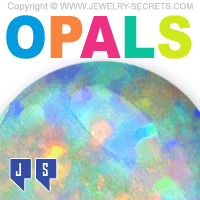LEARN ALL ABOUT THE GEMSTONE OPAL
FASCINATING FACTS ABOUT THE OPAL GEMSTONE, OCTOBER BIRTHSTONE, HARDNESS, FOLKLORE, COLORS...
This post contains affiliate links. If you use these links to buy something I may earn a commission. Thanks! As an Amazon Associate I also earn from qualifying purchases.

Opals are a unique and stunning gemstone that is beloved by many, especially those born in October.
This gemstone has a rich history, unique properties, and a wide range of colors, making it one of the most fascinating gemstones in the world. In this article, we will delve deeper into the world of opals, exploring their hardness, colors, origin, folklore, and different types.
Hardness
Opal is a relatively soft gemstone, with a hardness rating of 5.5 to 6.5 on the Mohs scale. This means that it is not as durable as other gemstones like diamonds, sapphires, or rubies. Opal is a hydrated form of silica, which means it contains water. This water content makes opal more prone to cracking or breaking if exposed to high temperatures (like ultrasonic cleaners) or rapid changes in temperature. Because of this, opals should be handled with care and stored in a cool, dry place.
Colors
One of the most striking features of opals is their color. Opals can display a wide range of colors, from white and gray to red, orange, yellow, green, blue, and purple. The colors in opals are caused by the diffraction and interference of light as it passes through the tiny silica spheres that make up the gemstone. The size and arrangement of these spheres determine the color and pattern of the opal.
Opals can also be classified based on the colors they display. Precious opals are those that exhibit a play of color, which is a phenomenon where the gemstone appears to change colors as it is viewed from different angles. Common opals, on the other hand, do not have this play of color and are typically opaque or translucent in appearance.
Origin
Opals are found in many parts of the world, but the majority of the world’s supply comes from Australia. In fact, Australia produces over 90% of the world’s opals. Other countries that produce opals include Brazil, Ethiopia, Mexico, Peru, and the United States.
Folklore
Opals have a rich history and have been prized for their beauty for thousands of years. In ancient times, opals were believed to possess magical powers and were used for healing and spiritual purposes. The ancient Greeks believed that opals gave the wearer the power of foresight and the ability to predict the future. The Romans believed that opals were a symbol of hope and purity, and that they protected the wearer from disease and harm.
In the Middle Ages, opals were believed to have the power to make the wearer invisible. This belief led to the widespread use of opals in jewelry worn by thieves and spies. In more recent times, opals have been associated with love and passion. They are often given as gifts to celebrate weddings and anniversaries.
Types
Opals can be classified into several different types, based on their appearance and other characteristics. The most common types of opals are:
- White Opals: These opals are mainly white, with flashes of other colors.
- Black Opals: These opals have a dark body color, which makes the play of color more vivid and striking.
- Boulder Opals: These opals are found in ironstone boulders and have a natural backing of the host rock.
- Crystal Opals: These opals are transparent or semi-transparent and have a play of color.
- Fire Opals: These opals are known for their intense orange, yellow, or red color, and do not display a play of color.
- Ethiopian Opals: These opals are relatively new to the market and are known for their bright colors and striking play of color.
- Mexican Opals: These opals are known for their fiery orange, red, and yellow colors, and are often cut into cabochons.
Opals also come in a variety of shapes and sizes, with popular cuts including oval, round, pear, and cushion. Some opals are even cut into unique shapes to showcase their individual patterns and colors.
In conclusion, opals are a fascinating gemstone that have captured the hearts of many throughout history. Their unique properties and wide range of colors make them a truly special gemstone, and their association with love and passion has made them a popular choice for jewelry. Whether you’re born in October or simply appreciate the beauty of opals, these gemstones are sure to leave a lasting impression.
Check out all of the beautiful Opals here on Amazon.
Cheers! :)


















Leave a comment